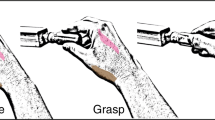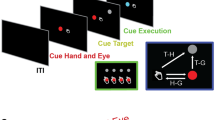Abstract
Movement perception relies on sensory feedback, but the involvement of efference copies remains unclear. We investigated movements without proprioceptive feedback using ischemic nerve block during fMRI in healthy humans, and found preserved activation of the primary somatosensory cortex. This activation was associated with increased interaction with premotor cortex during voluntary movements, which demonstrates that perception of movements relies in part on predictions of sensory consequences of voluntary movements that are mediated by the premotor cortex.
This is a preview of subscription content, access via your institution
Access options
Subscribe to this journal
Receive 12 print issues and online access
$209.00 per year
only $17.42 per issue
Buy this article
- Purchase on Springer Link
- Instant access to full article PDF
Prices may be subject to local taxes which are calculated during checkout

Similar content being viewed by others
References
Flanagan, J.R., Vetter, P., Johansson, R.S. & Wolpert, D.M. Curr. Biol. 13, 146–150 (2003).
von Holst, E. & Mittelstaedt, H. Naturwissenschaften 37, 464–476 (1950).
Sperry, R.W. J. Comp. Physiol. Psychol. 43, 482–489 (1950).
Taub, E., Ellman, S.J. & Berman, A.J. Science 151, 593–594 (1966).
Forget, R. & Lamarre, Y. Hum. Neurobiol. 6, 27–37 (1987).
Cole, J.D. & Katifi, H.A. Electroencephalogr. Clin. Neurophysiol. 80, 103–107 (1991).
Sinclair, D.C. J. Neurophysiol. 11, 75–92 (1948).
Laszlo, J.I. Q. J. Exp. Psychol. 18, 1–8 (1966).
Hoffmann, P. (Springer Verlag, Berlin, 1922).
Blakemore, S.-J., Wolpert, D.M. & Frith, C. Nat. Neurosci. 1, 635–640 (1998).
Haggard, P. & Whitford, B. Brain Res. Cog. Brain Res. 19, 52–58 (2004).
Ellaway, P.H., Prochazka, A., Chan, M. & Gauthier, M.J. J. Physiol. (Lond) 556, 651–660 (2004).
Büchel, C. & Friston, K.J. Cereb. Cortex 7, 768–778 (1997).
Blankenburg, F., Ruff, C.C., Deichmann, R., Rees, G. & Driver, J. PLoS Biol. 4, e69 (2006).
Tanné-Gariépy, J., Rouiller, E.M. & Boussaoud, D. Exp. Brain Res. 145, 91–103 (2002).
Acknowledgements
We would like to thank T.E. Lund, J.B. Rowe and the Simon Spies Foundation.
Author information
Authors and Affiliations
Contributions
M.S.C. designed and performed the experiment, conducted the data analysis and wrote the manuscript. J.L.-J., S.S.G. and T.H.P. all performed the experiment. O.B.P. supervised the experiment, provided the scanner facilities and handled the ethical approval. J.B.N. designed, supervised and conducted the experiments and helped write the manuscript.
Corresponding author
Ethics declarations
Competing interests
The authors declare no competing financial interests.
Supplementary information
Supplementary Fig. 1
H-reflex measurements before and after cuff inflation recorded at regular intervals until it disappeared. (PDF 146 kb)
Supplementary Fig. 2
Regions depicted in green-yellow display regions that are significantly more activated during INB than in pre, post and post baseline in the control experiment without visual feedback, i.e. the conjunction (C2n>C1n ^ C2n>C3n ^ C2n>C4n) (thresholded at q<0.05 FDR-correction). In red is depicted the regions of vPMC showing more activation in the main experiment during INB. (PDF 304 kb)
Supplementary Fig. 3
Regions depicted in green show a higher correlation with the activity in S1 during INB than before INB in the main experiment. Regions depicted in yellow show an effect of cuff inflation before sensory block, i.e. activation related to the extra sensory stimulation that the cuff inflation might cause. (PDF 269 kb)
Supplementary Fig. 4
S1 activation decrease during INB with electrical stimulation in two subjects. (PDF 267 kb)
Supplementary Fig. 5
Regions showing increased activation during INB compared with the situation before INB, i.e. the contrasts C2>C1, during voluntary movements. (PDF 510 kb)
Supplementary Fig. 6
Maximum intensity projections from the control experiment without visual feedback showing regions where there is more activation during INB C2n compared to a – pre INB and b – pre INB with inflated cuff. (PDF 217 kb)
Rights and permissions
About this article
Cite this article
Christensen, M., Lundbye-Jensen, J., Geertsen, S. et al. Premotor cortex modulates somatosensory cortex during voluntary movements without proprioceptive feedback. Nat Neurosci 10, 417–419 (2007). https://doi.org/10.1038/nn1873
Received:
Accepted:
Published:
Issue Date:
DOI: https://doi.org/10.1038/nn1873



